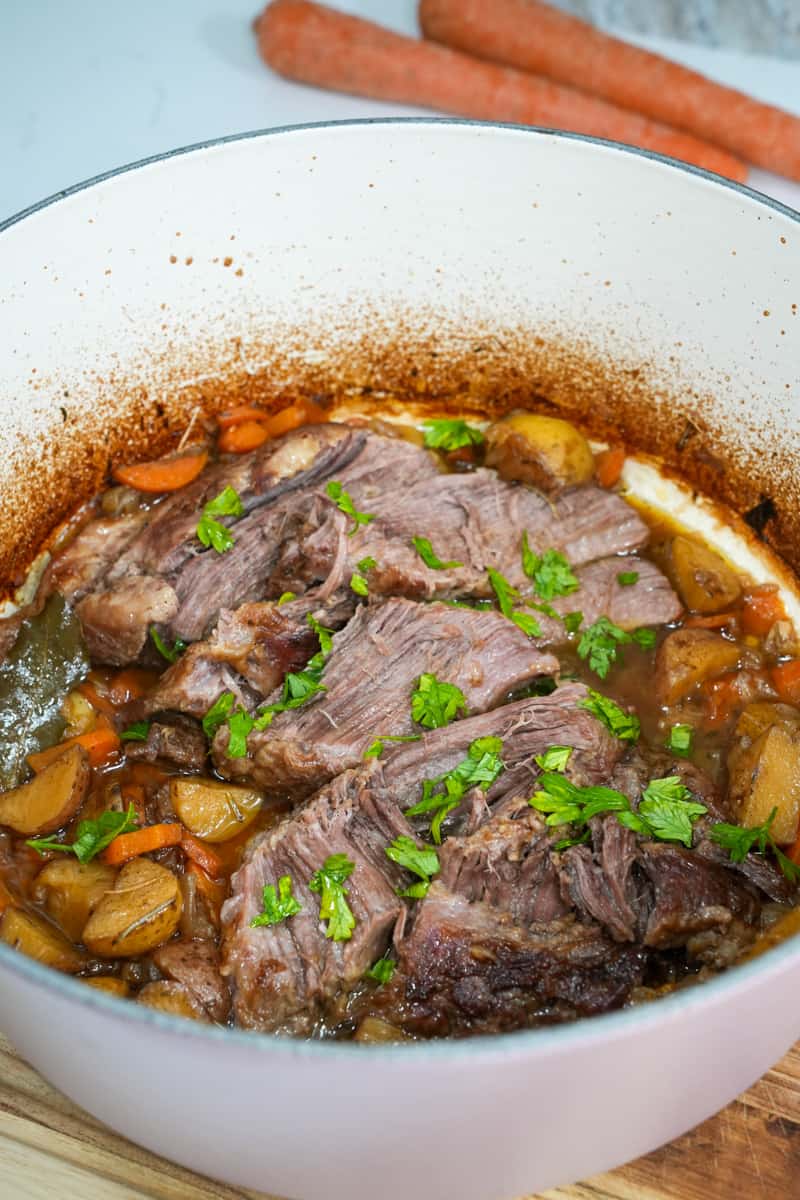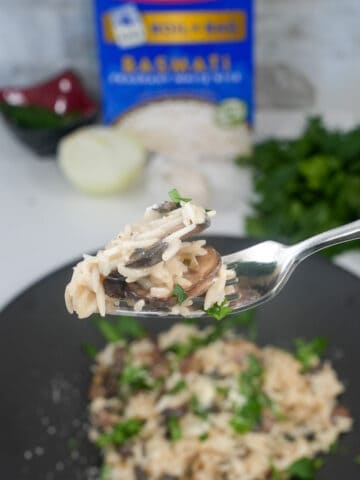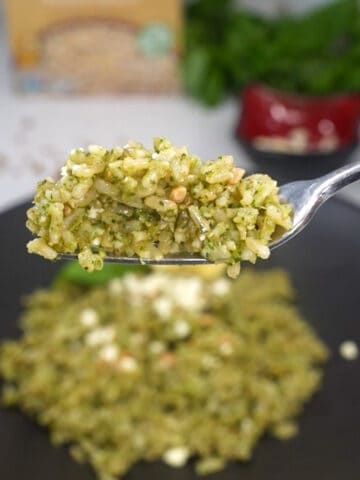This Pork Pot Roast Recipe is a pork dish made by slow-cooking a usually tough cut of meat in a dutch oven, and it made with so many vegetables.

In the midst of our bustling lives, there's something profoundly comforting about returning to the basics—simple, hearty meals that warm the soul and fill the home with irresistible aromas. Today, we embark on a culinary journey into the heart of rustic cooking with a recipe that epitomizes comfort and flavor: this Pork Pot Roast Recipe.
Imagine tender pork shoulder or butt, seasoned to perfection with flour, salt, pepper, and a touch of garlic powder, slowly roasting in a fragrant blend of herbs and vegetables. This dish is a celebration of simplicity, yet its rich taste and comforting textures make it a true showstopper at any table.
Check out these recipes that are similar: Tinga de Res and Ropa Vieja.
Jump to:
- What is Pork Pot Roast?
- What cut of meat for pot roast pork?
- What's the difference between pulled pork and pork roast?
- Why is a Pork Pot Roast so great?
- Pork Pot Roast Recipe Ingredients
- How to make Pork Pot Roast Recipe
- What to serve with Pork Pot Roast
- Does pork roast get more tender the longer you cook it?
- Substitutions
- Pork Pot Roast Recipe Variations
- Equipment
- How to store Pork Pot Roast
- Pork Pot Roast Recipe Top tips
- Pot Roast Recipe
- Food safety
What is Pork Pot Roast?
A Pork Pot Roast is a classic and comforting dish that involves slow-cooking a tough cut of pork, usually pork shoulder or butt, in a pot with a variety of vegetables, herbs, and liquids. The slow-cooking process allows the pork to become incredibly tender and infused with the flavors of the surrounding ingredients.
What cut of meat for pot roast pork?
For pot roast pork, the ideal cut of meat is one that is well-suited for slow cooking, allowing it to become tender and flavorful over time. The most commonly recommended cuts for pork pot roast include:
- Pork Shoulder (Pork Butt): This cut is often favored for pot roasts due to its marbling and higher fat content. It becomes incredibly tender and moist when slow-cooked, making it a popular choice for pot roast recipes.
- Pork Butt Roast: Despite the name, pork butt is actually from the upper shoulder area of the pig. It's a versatile cut that works well for pot roasts, pulled pork, and other slow-cooking methods.
- Pork Picnic Roast: This cut comes from the lower part of the shoulder and is slightly leaner than pork butt. It can also be used for pot roasts and benefits from the slow-cooking process.

What's the difference between pulled pork and pork roast?
Pulled pork and pork roast are related dishes, but they differ in terms of preparation, cooking method, and sometimes the final presentation. Here are the key distinctions between pulled pork and pork roast:
Pulled Pork:
- Cut of Meat: Pulled pork is typically made from pork shoulder or pork butt, which are well-marbled cuts with a good amount of fat.
- Cooking Method: Pulled pork is often slow-cooked or smoked over a long period, allowing the connective tissues and collagen in the meat to break down. This slow cooking results in tender, easily shredded pork.
- Shredding: After cooking, the pork is shredded or "pulled" into small, bite-sized pieces using forks or other utensils. The shredded meat is often mixed with barbecue sauce or other flavorful sauces.
- Uses: Pulled pork is commonly used as a filling for sandwiches, tacos, or sliders. It's a popular choice for barbecue-style dishes.
Pork Roast:
- Cut of Meat: Pork roast can be made from various cuts, but it often involves cuts like pork loin, pork sirloin roast, or even a pork shoulder or butt. The choice of cut can influence the final texture and flavor.
- Cooking Method: Pork roast is generally slow-cooked in the oven or a slow cooker. The goal is to cook the meat until it's tender and can be easily sliced.
- Serving: Instead of being shredded, pork roast is typically carved into slices for serving. It can be served with its cooking juices or a flavorful gravy.
- Uses: Pork roast is often served as a main dish with side dishes like roasted vegetables, mashed potatoes, or rice. It's a classic, hearty meal.
Why is a Pork Pot Roast so great?
- Tender and Juicy Meat: The slow-cooking process used in a pot roast is ideal for tougher cuts of pork, such as shoulder or butt. The extended cooking time allows the connective tissues in the meat to break down, resulting in exceptionally tender and juicy pork.
- Rich and Deep Flavors: The combination of herbs, vegetables, and liquids in the pot creates a flavorful broth that infuses the pork with rich and deep flavors. The use of ingredients like garlic, rosemary, thyme, and red wine contributes to a complex taste profile that is both satisfying and comforting.
- Versatility: A Pork Pot Roast is a versatile dish that can be customized to suit personal preferences. You can adjust the seasonings, vegetables, and liquids to create variations of the dish that cater to different tastes.
- One-Pot Convenience: The beauty of a pot roast lies in its simplicity and the fact that it's a one-pot meal. After initial preparations, you can let the dish slow-cook in the oven, allowing you to attend to other tasks or simply relax while the enticing aroma fills your home.
Pork Pot Roast Recipe Ingredients
- Pork shoulder or butt
- Flour
- Salt and pepper
- Garlic powder
- Butter
- Olive oil
- Onion
- Carrots
- Potatoes
- Dried rosemary
- Dried thyme
- Chicken broth
- Red wine (optional)
- Bay leaves
- Parsley
See recipe card for Pot Roast Recipe quantities.
How to make Pork Pot Roast Recipe

Preheat your oven to 325°F (163°C).
In a large bowl, combine the flour, salt, pepper, and garlic powder. Dredge the pork shoulder or butt in the flour mixture, ensuring it's well-coated.
In a large Dutch oven or oven-safe pot, heat the butter and olive oil over medium-high heat. Brown the pork on all sides until it develops a golden crust. This step helps seal in the juices.

Remove the pork from the pot and set it aside. In the same pot, add the sliced onion and cook until it becomes translucent. Add the carrots and potatoes to the pot, stirring them with the onions for a few minutes until they start to soften.
Place the browned pork back into the pot, nestling it among the vegetables. Sprinkle the dried rosemary and thyme over the meat and vegetables.

Pour in the chicken broth and red wine (if using). The liquid should come about halfway up the sides of the pork. Add the bay leaves. Cover the pot with a lid and transfer it to the preheated oven. Roast for 1.5 to 2 hours or until the pork is tender and easily pulls apart with a fork.

Once cooked, remove the pot from the oven. Discard the bay leaves. Taste the broth and adjust the seasoning if necessary. Garnish with fresh parsley just before serving.
Rest Before Serving: Let the pot roast rest for a few minutes before serving to allow juices to redistribute.
What to serve with Pork Pot Roast
- Mashed Potatoes: Creamy mashed potatoes are a classic accompaniment to Pot Roast. The velvety texture and buttery flavor of mashed potatoes complement the rich flavors of the pot roast and provide a perfect base for soaking up the delicious pan juices or gravy.
- Roasted Vegetables: Roasting vegetables like carrots, potatoes, and root vegetables adds a depth of flavor and brings out their natural sweetness. The caramelization of the vegetables pairs well with the savory pot roast and provides a variety of textures to the meal.
- Biscuits or Cornbread: A warm batch of homemade biscuits or cornbread is a delightful addition to a Pot Roast meal. These bread options can be used to soak up the flavorful pan juices and enhance the overall experience.
- Braised Greens: Southern-style braised greens, such as collard greens, turnip greens, or mustard greens, add a burst of flavor and provide a balance to the richness of the pot roast. The tender, slightly bitter greens offer a refreshing contrast to the meaty dish.
- Green Beans: Steamed or sautéed green beans make a simple and vibrant side dish for Pot Roast. They provide a fresh and crisp element to the meal, complementing the rich flavors of the meat.
Does pork roast get more tender the longer you cook it?
Yes, pork roast generally becomes more tender the longer it is cooked, especially when using slow-cooking methods. Tough cuts of pork, such as pork shoulder or butt, contain connective tissues like collagen. Cooking these cuts at a low temperature for an extended period allows these collagen fibers to break down and convert into gelatin. This process results in a more tender and succulent texture.

Substitutions
- Pork Shoulder or Butt: You can substitute with beef chuck roast for a beef pot roast or lamb shoulder for a different flavor profile.
- Flour: To make the dish gluten-free, use a gluten-free all-purpose flour or cornstarch for dredging the pork.
- Butter: Substitute with ghee or a plant-based butter for a dairy-free version.
- Red Wine (Optional): If you prefer not to use wine, you can replace it with additional chicken broth or beef broth for added richness.
- Olive Oil: Any neutral cooking oil, such as vegetable or canola oil, can be used as a substitute.
- Dried Rosemary and Thyme: Use fresh rosemary and thyme if available, or experiment with other dried or fresh herbs like sage, oregano, or marjoram.
- Chicken Broth: Vegetable broth or beef broth can be used as a substitute, depending on your preference or dietary restrictions.
- Onion: Shallots or leeks can be used as alternatives, providing a slightly different flavor profile.
- Carrots: Replace with parsnips or sweet potatoes for a twist on the classic recipe.
- Potatoes: Try using Yukon Gold, red potatoes, or even turnips for a variation in texture and flavor.
- Garlic Powder: Use fresh minced garlic cloves for a more intense garlic flavor.
- Bay Leaves: If you don't have bay leaves, you can omit them, or use a small amount of dried thyme or oregano for added aroma.
- Fresh Parsley (Garnish): Chopped fresh cilantro, chives, or green onions can be used as alternative garnishes.
Pork Pot Roast Recipe Variations
- Apple Cider Pork Pot Roast: Substitute chicken broth with apple cider for a sweet and tangy flavor.
- Balsamic Glazed Pork Pot Roast: Add balsamic vinegar to the broth for a tangy kick.
- Asian-Inspired Pork Pot Roast: Infuse soy sauce, ginger, and sesame oil into the broth.
- Mediterranean Pork Pot Roast: Use red wine, add tomato paste for richness, and include olives and artichoke hearts.
- Spicy Southwest Pork Pot Roast: Season with cumin, chili powder, and cayenne; add corn, black beans, and green chilies.
- Citrus-Infused Pork Pot Roast: Squeeze orange juice into the broth; add orange zest or slices.
- Herb and Mustard Crusted Pork Pot Roast: Create a rub with Dijon mustard, thyme, and rosemary for the pork.
- Maple Glazed Pork Pot Roast: Substitute some broth with maple syrup for a sweet and savory glaze.
You can always use the leftover meat to make Birria Tacos - just skip to step 3.
Equipment
- Dutch Oven or Large Pot with Lid: A Dutch oven or a large, heavy-bottomed pot with a tight-fitting lid is ideal for cooking the pot roast. It allows for even heat distribution and retains heat well. I recommend using a Le Creuset dutch oven for this recipe. I have always been obsessed with their Classic Round Dutch Oven (7.25-qt used here) because their cast-iron design works perfectly for cooking tough meats, like pot roast, because of its durability, heavy lid and heat distribution.
- Cutting Board and Knife: A sturdy cutting board and a sharp knife are essential for preparing the ingredients, such as chopping onions and carrots.
- Tongs or Meat Fork: Tongs or a meat fork will come in handy for flipping and handling the roast while searing it.
- Measuring Cups and Spoons: Accurate measurements are important when adding ingredients like spices, liquids, and seasonings to achieve the desired flavor.
- Wooden Spoon or Spatula: A wooden spoon or spatula is useful for stirring the ingredients and scraping the bottom of the pot to prevent sticking.
- Cooking Utensils: Basic cooking utensils like a ladle, slotted spoon, and kitchen tongs will be useful for serving and handling the pot roast and its accompanying ingredients.
- Meat Thermometer: A meat thermometer ensures that the pot roast is cooked to the desired level of doneness. It helps you avoid overcooking or undercooking the meat.
- Oven Mitts: Oven mitts or heat-resistant gloves are essential for handling hot pots, pans, and roasts during the cooking process.
- Serving Platter: A large serving platter or a deep dish will be useful for presenting the pot roast and its accompanying vegetables.

How to store Pork Pot Roast
To store my Pot Roast Recipe properly, follow these guidelines:
- Refrigeration: Allow the pot roast to cool completely before storing it in the refrigerator. Place the roast and any leftover vegetables and gravy in an airtight container or wrap them tightly with plastic wrap or aluminum foil.
- Separate Storage: If possible, store the pot roast and its components separately. Keep the meat and vegetables in separate containers to maintain their individual flavors and textures.
- Proper Labeling: Label the containers with the date of preparation to ensure you can track the freshness of the stored pot roast. Use a permanent marker or labels that adhere well to the containers.
- Storage Duration: Pot Roast can be stored in the refrigerator for up to 3-4 days. Consume it within this time frame to maintain its flavor and quality.
- Freezing: If you want to extend the storage time, you can freeze the pot roast. Wrap it tightly in plastic wrap or aluminum foil, or place it in a freezer-safe container or freezer bag. Make sure to remove as much air as possible to prevent freezer burn.
- Reheating: To reheat the pot roast, transfer it to a microwave-safe dish or a saucepan and warm it gently over low heat. You can also reheat individual servings in the microwave.
- Quality Check: Before consuming the stored pot roast, check for any signs of spoilage such as an off smell, unusual texture, or mold. If it looks or smells questionable, it's best to discard it to ensure food safety.
Pork Pot Roast Recipe Top tips
- Sear for Flavor: Before slow-cooking, sear the pork on all sides to create a flavorful crust and seal in juices.
- Choose Marbled Cuts: Opt for well-marbled cuts like pork shoulder or butt for a more succulent and tender result.
- Customize Vegetables: Experiment with vegetables based on personal preference, adding variety to the dish.
- Fresh Herbs for Aroma: If available, use fresh herbs in addition to or instead of dried for a more aromatic flavor.
- Low and Slow: Allow the pot roast to cook at a low temperature for an extended period, ensuring tenderness and flavor development.
- Balance the Liquid: Ensure the liquid level covers about halfway up the pork for a moist and flavorful result.
- Wine for Depth: Adding red wine enhances depth, but it's optional; adjust quantities based on personal preference.
- Check for Doneness: Test doneness by ensuring the pork easily pulls apart with a fork.
- Rest Before Serving: Let the pot roast rest for a few minutes before serving to allow juices to redistribute.

Pot Roast Recipe
- Total Time: 2 hours 15 minutes
- Yield: 4 servings 1x
Description
This Pot Roast Recipe is made with pork shoulder, vegetables, and is roasted in the oven for two hours.
Ingredients
- 3-4 pounds pork shoulder or butt
- ½ cup all-purpose flour
- Salt and pepper to taste
- 1 tablespoon garlic powder
- 2 tablespoons butter
- 2 tablespoons olive oil
- 1 large onion, sliced
- 3 carrots, peeled and chopped into chunks
- 4 potatoes, peeled and chopped into chunks
- 1 teaspoon dried rosemary
- 1 teaspoon dried thyme
- 2 cups chicken broth
- 1 cup red wine (optional)
- 2 bay leaves
- Fresh parsley for garnish
Instructions
- Preheat your oven to 325°F (163°C).
- In a large bowl, combine the flour, salt, pepper, and garlic powder. Dredge the pork shoulder or butt in the flour mixture, ensuring it's well-coated.
- In a large Dutch oven or oven-safe pot, heat the butter and olive oil over medium-high heat. Brown the pork on all sides until it develops a golden crust. This step helps seal in the juices.
- Remove the pork from the pot and set it aside. In the same pot, add the sliced onion and cook until it becomes translucent.
- Add the carrots and potatoes to the pot, stirring them with the onions for a few minutes until they start to soften.
- Place the browned pork back into the pot, nestling it among the vegetables. Sprinkle the dried rosemary and thyme over the meat and vegetables.
- Pour in the chicken broth and red wine (if using). The liquid should come about halfway up the sides of the pork. Add the bay leaves.
- Cover the pot with a lid and transfer it to the preheated oven. Roast for 2.5 to 3 hours or until the pork is tender and easily pulls apart with a fork.
- Once cooked, remove the pot from the oven. Discard the bay leaves. Taste the broth and adjust the seasoning if necessary.
- Garnish with fresh parsley just before serving.
Notes
Sear for Flavor: Before slow-cooking, sear the pork on all sides to create a flavorful crust and seal in juices.
Choose Marbled Cuts: Opt for well-marbled cuts like pork shoulder or butt for a more succulent and tender result.
Customize Vegetables: Experiment with vegetables based on personal preference, adding variety to the dish.
Fresh Herbs for Aroma: If available, use fresh herbs in addition to or instead of dried for a more aromatic flavor.
Low and Slow: Allow the pot roast to cook at a low temperature for an extended period, ensuring tenderness and flavor development.
Balance the Liquid: Ensure the liquid level covers about halfway up the pork for a moist and flavorful result.
Wine for Depth: Adding red wine enhances depth, but it's optional; adjust quantities based on personal preference.
Check for Doneness: Test doneness by ensuring the pork easily pulls apart with a fork.
Rest Before Serving: Let the pot roast rest for a few minutes before serving to allow juices to redistribute.
- Prep Time: 15 minutes
- Cook Time: 2 hours
- Category: Dinner
- Method: Roasting
- Cuisine: American
Food safety
- Cook to a minimum temperature of 165 °F (74 °C)
- Do not use the same utensils on cooked food, that previously touched raw meat
- Wash hands after touching raw meat
- Don't leave food sitting out at room temperature for extended periods
- Never leave cooking food unattended
- Use oils with high smoking point to avoid harmful compounds
- Always have good ventilation when using a gas stove







Leave a Reply